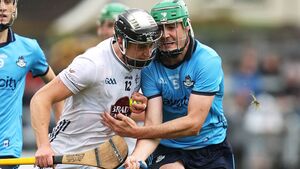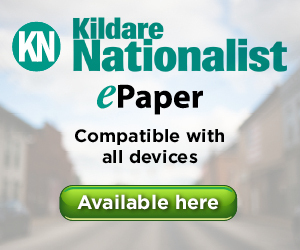The history of hurling in Athy

Kildare's David Qualter and Paddy Doyle of Dublin in action during their recent championship game Photo: INPHO/Bryan Keane
‘A KILKENNY man exiled in Kildare’ is a phrase I have used on many occasions to explain my background, but never have I had the opportunity to share the joy of Kildare and Kilkenny hurling matches in Croke Park on the same day.
The Kildare/Laois and Kilkenny/Galway hurling finals were a joyful occasion for me. I must confess I had not previously seen the Kildare senior hurlers at play. I was pleasantly surprised at the quality of their hurling.
The Kildare/Laois match was most enjoyable insofar as I was concerned, far more enjoyable than the Cork/Limerick match the previous day. That in my view was a brutalised form of hurling where the player catching the ball aloft found himself when back on ground surrounded by three or four opponents with encircling arms and hurleys, making him a prisoner.
Why is it not a foul against the players using their arms and hurleys in this way is something which puzzles me? Two great results gave me much joy on Sunday and irrespective of what happens to Kildare in the coming weekend, the skill and sportsmanship of the Kildare team members will stay with me forever.
Athy is not regarded as a hurling town, but records show that as early as 1887 a hurling club was formed in the town and Dan Whelan of Fontstown was making hurleys for the club. An Athy hurling team played a Rathdowney selection in 1898 and suffered defeat on a score of 3-13 to no score. A previous reference I came across in relation to hurling in Athy was a match played in 1890.
Athy’s first hurling club would appear to have faded away for I next find in 1906 the Catholic Young Men’s Society establishing Athy’s C.Y.M.S. hurling and football club. The present GAA grounds in Geraldine Park were first used by the club for club games and inter county games after 1906.
It would appear the C.Y.M.S. Hurling and Football Club was subsequently replaced by a town-based club whose first major success was in the 1928 County Senior Hurling Final when Athy defeated Johnstown Bridge.
Athy contested the county final the following year but lost to McDonagh Barracks of the Curragh.
Athy defeated Broadford to win the 1936 Senior Championship.
The same team reached the county final the following year but lost by two points to Maynooth. That same year an Athy junior team won the Junior County Championship following the lodgment of an objection against Kill who had defeated Athy 6-4 to 1-4 in the final.
The local Christian Brothers School organised a hurling team in 1934 on the arrival of Brother P.P. Farrell to Athy. Success arrived two years later when Athy CBS defeated Kilkenny CBS in the first round of the Leinster College Junior Championship.
The Athy school team went on to defeat O’Connell school Dublin in Croke Park that same year. The team comprised all local young lads including Des Hurley, Tadhg Brennan, Dinny Fox, Jim Malone, Joe Gibbons, Paddy Garrett, Joe O’Neill, Lal Murray, Eddie Purcell, Jack Dunne, John Gannon, Frank Kelly, Pat Smyth, Noel Blanchfield, Dick Davis and Munsie Purcell.
The Athy Club junior hurlers were crowned champions in 1950 but the club appears to have gone into decline until revived in 1957 by John Dooley of St Patrick’s Avenue. John, a native of Paulstown, Co. Kilkenny, came to Athy in 1930. A keen and ardent follower of hurling, he was one of the driving forces behind the club for many years. He was a playing member until 1937 and won a senior hurling championship medal with the club in 1936. Under his guidance hurling in Athy flourished.
In 1934, John was chairman of the Kildare Hurling Board and he represented Athy at the Kildare conventions and county board meetings. He retired from administrative duties with the Athy club in 1968. I remember John’s enthusiasm for hurling and his encouragement to youngsters like myself who in the mid-1950s practiced their hurling in the fields at Chanterlands.
My hurling career was shortened by the engagement of a hurley to my forehead during one of the Chanterlands practice matches. A lack of skill on my part resulted in a split forehead, courtesy of a hurley yielded by my friend Mick Rowan and a rush to the local doctor who stitched the wound. My retirement from hurling was inevitable.
The Athy senior team was defeated in a county final in 1964 and the club now has an under 16 hurling team which was promoted from the 15-year age group last year. A county junior championship was won in 1989 which resulted in the club being promoted to senior level. The club with such a glorious history is now operating at junior level.
Tadhg Brennan drew up a constitution for Athy Hurling and Football Club in 1945 and I have a leaflet from a later date headed ‘Geraldine Hurling and Football Club’. I am told that hurling and football are no longer operated under the same club name, but operate as separate clubs.
Why is it that the Gaelic teams of hurling and football should not come under the same club name, ‘Geraldine Hurling and Football Club’?






